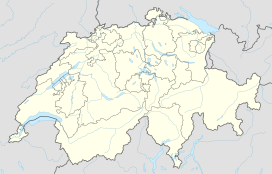Dunantspitze
| Dunantspitze | |
|---|---|
| Ostspitze | |

|
|
| Highest point | |
| Elevation | 4,632 m (15,197 ft) |
| Prominence | 15 m (49 ft) |
| Isolation | 0.1 kilometres (0.062 mi) |
| Parent peak | Monte Rosa |
| Coordinates | 45°56′13″N 7°52′04″E / 45.93694°N 7.86778°ECoordinates: 45°56′13″N 7°52′04″E / 45.93694°N 7.86778°E |
| Naming | |
| Translation | Peak Dunant |
| Geography | |
| Location | Valais, Switzerland |
| Parent range | Pennine Alps |
| Climbing | |
| First ascent | 12 August 1848 by Johann Madutz and Matthias Zumtaugwald or 1 September 1854 by Ulrich Lauener, Johann and Matthias Zumtaugwald guiding Christopher, Edmund and James G. Smyth |
| Easiest route | West ridge from the Sattel or south-east ridge via the Grenzgipfel. |
The Dunantspitze (German for "Peak Dunant", 4,632 m), formerly called Ostspitze ("Eastern Peak"), is a peak of the Monte Rosa Massif in the Pennine Alps in Switzerland. It is the second highest peak of the massif, after the Dufourspitze (4,634 m) and the second highest summit in Switzerland, but its prominence is only about 15 metres. At the time of its first ascent it was unclear which of the summits was the higher.
Dunantspitze and Dufourspitze were originally just the eastern and western summits (Ostspitze and Westspitze) of the Gornerhorn. Westspitze was renamed Dufourspitze in 1863 in honour of Guillaume-Henri Dufour, while Ostspitze retained its name until October 2014. It was then renamed Dunantspitze in honour of Henry Dunant, the Swiss founder of the International Committee of the Red Cross (ICRC) in 1863.
The first approaches to the Gornerhorn were made from the northern slopes over the Gorner glacier via the Silbersattel (4,510 m). This pass was first reached on August 12, 1847, by the Zermatt guides Matthias and Johann Zumtaugwald/zum Taugwald, Johann Brantschen and Joseph Moser guiding the French professors Victor Puisieux and Edouard Ordinaire. Precisely a year later (12 August 1848), Johann Madutz from Matt, Glarus, and Matthias Zumtaugwald guided the Swiss theologian to the pass for an ascent of the highest summit. Ulrich had to give up, but the guides proceeded to climb to what they thought to be the Ostspitze and established a new altitude record in Switzerland (which since 1820 had been held at 4,563 m by the climbers of the Zumsteinspitze). The descent over the same route was so tricky that Madutz at places had to lower down Zumtaugwald by rope. Three years later, on 22 August 1851, Johann Zumtaugwald returned, with Peter Taugwalder and Peter Inderbinen and the Swiss botanist brothers Adolf and Hermann Schlagintweit to repeat this ascent. They did not dare to traverse to the western summit, which the Schlagintweits measured to be 7 meters higher.
...
Wikipedia

